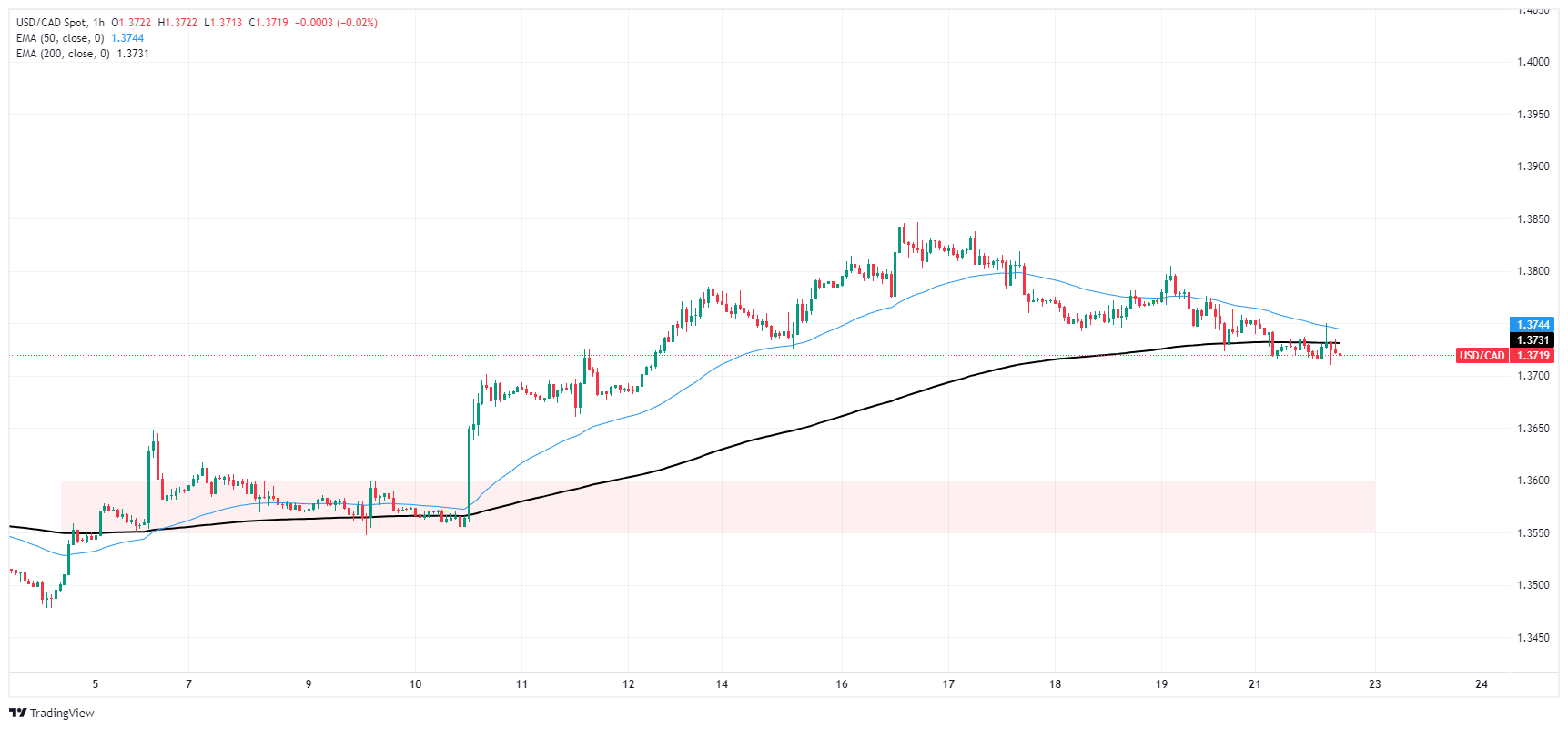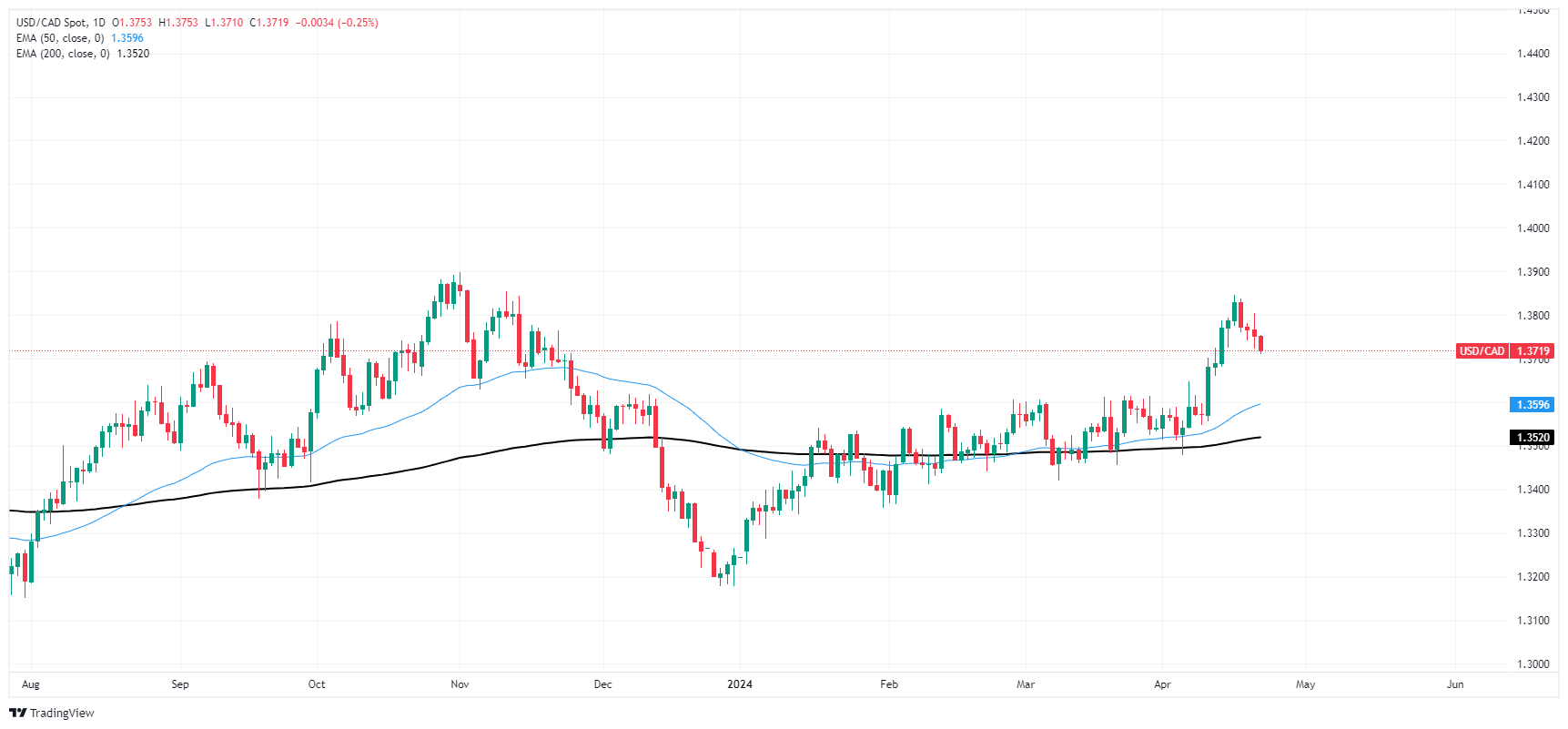- The Canadian dollar is trading higher, waiting for key data to indicate its direction.
- The data highlight for Canada will be Wednesday's CAD Retail Sales.
- US PMIs on Tuesday are expected to show a slight pick-up in activity.
The Canadian Dollar (CAD) advances moderately on Monday, trading in the green against most major currencies. Both the US and Canadian dollars are awaiting relevant data.
On Monday, Canada presented strictly economic data, with a rebound in the Commodity Price Index. At the same time, prices of industrial products exceeded expectations but the figures were lower than previous figures. The Canadian new home price index stagnated in March, missing expectations and falling slightly from the same period last year.
Daily summary of market developments: Canadian dollar recovers amid stable markets
- Canadian data on Monday delivered mixed results, but markets' attention remains focused on other issues, giving the CAD room.
- Canadian industrial product prices were at the expected 0.8% in March, a slight decline from the previous month's 1.1% (revised upward from 0.7%).
- The Canadian new home price index stagnated in March, at 0.0% versus 0.1% expected. The annual NPI fell by -0.4%, as housing prices falter after years of accelerated growth.
- Canada's commodity price index rose 3.7% in March, beating the forecast of 29%, up from 2.1% in February.
- Canadian Retail Sales for February will be released mid-week and are expected to rebound to 0.1% on Wednesday, following January's -0.3% decline.
- The US Purchasing Managers' Index (PMI) will be released on Tuesday, with the manufacturing component at 52.0 (51.9) and the services component at 52.0 (51.7%).
- Gross Domestic Product (GDP) and Personal Consumption Expenditure (PCE) will dominate the market's attention in the second half of the week.
Price of the Canadian Dollar today
Below is the percentage change of the Canadian Dollar (CAD) against the main currencies listed today. The Canadian dollar was the strongest currency against the British pound.
| USD | EUR | GBP | CAD | AUD | JPY | NZD | CHF | |
| USD | 0.11% | 0.26% | -0.19% | -0.24% | 0.12% | -0.20% | 0.14% | |
| EUR | -0.11% | 0.15% | -0.30% | -0.34% | 0.01% | -0.29% | 0.01% | |
| GBP | -0.26% | -0.15% | -0.45% | -0.49% | -0.14% | -0.45% | -0.13% | |
| CAD | 0.19% | 0.30% | 0.45% | -0.05% | 0.30% | 0.00% | 0.31% | |
| AUD | 0.24% | 0.35% | 0.49% | 0.05% | 0.35% | 0.04% | 0.37% | |
| JPY | -0.12% | 0.00% | 0.14% | -0.29% | -0.35% | -0.31% | 0.02% | |
| NZD | 0.19% | 0.28% | 0.42% | 0.01% | -0.04% | 0.30% | 0.30% | |
| CHF | -0.12% | -0.01% | 0.13% | -0.31% | -0.35% | -0.01% | -0.31% |
The heat map shows the percentage changes of the major currencies against each other. The base currency is chosen in the left column, while the quote currency is chosen in the top row. For example, if you choose the Euro in the left column and scroll down the horizontal line to the Japanese Yen, the percentage change that appears in the box will represent EUR (base)/JPY (quote).
Technical Analysis: Canadian Dollar Slowly Recovers, Eyes on 1.3700
The Canadian dollar rose on Monday, gaining four tenths against the British pound (GBP) and almost a third against the Swiss franc (CHF) and the Japanese yen (JPY). The CAD is outperformed by the Australian Dollar (AUD) and the New Zealand Dollar (NZD) as the antipodes regain recently lost ground.
The USD/CAD pair fell from last week's high at 1.3840, with an attempted bullish recovery falling short following a bearish rejection from the 1.3800 area. The pair is now heading towards 1.3700, which would clear the way towards a supply zone near 1.3550, as the Canadian Dollar breaks out below the technical support of the 200 hourly EMA near 1.3730.
Longer-term, Japanese candlesticks indicate that the USD/CAD pair could record its fourth consecutive decline, while the Canadian dollar continues to recover in the short term. The dollar failed to reclaim November highs near 1.3900, and the momentum threatens to send USD/CAD back into heavy congestion at the 200-day EMA just above the 1.3500 zone.
USD/CAD hourly chart
USD/CAD daily chart
Frequently Asked Questions about the Canadian Dollar
What factors determine the price of the Canadian dollar?
The key factors that determine the price of the Canadian dollar (CAD) are the level of interest rates set by the Bank of Canada (BoC), the price of oil, Canada's main export product, the health of its economy, inflation and the trade balance, which is the difference between the value of Canadian exports and its imports. Other factors are market confidence, that is, whether investors bet on riskier assets (risk-on) or look for safe assets (risk-off), with the risk-on being positive for the CAD. As its largest trading partner, the health of the US economy is also a key factor influencing the Canadian dollar.
How do Bank of Canada decisions affect the Canadian dollar?
The Bank of Canada (BoC) exerts significant influence over the Canadian Dollar by setting the level of interest rates that banks can lend to each other. This influences the level of interest rates for everyone. The BoC's main objective is to keep inflation between 1% and 3% by adjusting interest rates up or down. Relatively high interest rates are usually positive for the CAD. The Bank of Canada can also use quantitative easing and tightening to influence credit conditions, with the former being negative for the CAD and the latter being positive for the CAD.
How does the price of oil affect the Canadian dollar?
The price of oil is a key factor influencing the value of the Canadian Dollar. Oil is Canada's largest export, so the price of oil tends to have an immediate impact on the value of the CAD. Generally, if the price of oil rises, the CAD also rises, as aggregate demand for the currency increases. The opposite occurs if the price of oil falls. Higher oil prices also tend to lead to a higher probability of a positive trade balance, which also supports the CAD.
How does inflation data influence the value of the Canadian Dollar?
Although inflation has traditionally always been considered a negative factor for a currency, as it reduces the value of money, the opposite has actually happened in modern times, with the relaxation of cross-border capital controls. Higher inflation often leads central banks to raise interest rates, attracting more capital inflows from global investors looking for a lucrative place to store their money. This increases the demand for the local currency, which in the case of Canada is the Canadian Dollar.
How does economic data influence the value of the Canadian dollar?
The published macroeconomic data measures the health of the economy and may have an impact on the Canadian dollar. Indicators such as GDP, manufacturing and services PMIs, employment and consumer confidence surveys can influence the direction of the CAD. A strong economy is good for the Canadian dollar. Not only does it attract more foreign investment, but it may encourage the Bank of Canada to raise interest rates, resulting in a stronger currency. However, if economic data is weak, the CAD is likely to fall.
Source: Fx Street
I am Joshua Winder, a senior-level journalist and editor at World Stock Market. I specialize in covering news related to the stock market and economic trends. With more than 8 years of experience in this field, I have become an expert in financial reporting.







